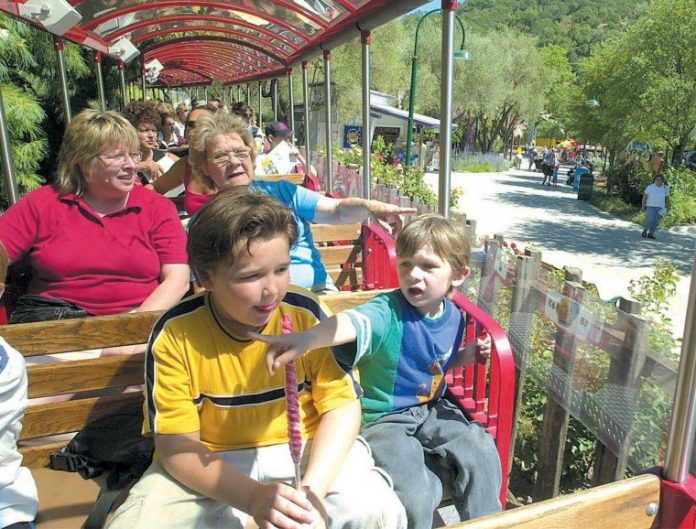GILROY
– Although 2002’s single top newsmaker appeared all in a flash,
a trend of several slower-moving changes that will affect the
landscape here for years to come simmered in the political
arena.
GILROY – Although 2002’s single top newsmaker appeared all in a flash, a trend of several slower-moving changes that will affect the landscape here for years to come simmered in the political arena.
About a year after another disaster catapulted them into the public eye on the East Coast, firefighters took center stage again in 2002 as they fought a dramatic battle against the Croy wildfire in the hillsides west of Gilroy and Morgan Hill.
The blaze took its toll, leaving some 30 homes and more than 3,000 lushly carpeted acres smoldering in its wake before an army of thousands of firefighters from all over the state could encircle and wrest control of it.
But not everything was about tragedy: The descent of major regional media and its 24-hour news cycle on South County also unearthed countless stories of charity and cooperation.
And in another entirely different sense, 2002 was more a year about building up, as local leaders laid the groundwork for several major changes to come throughout Gilroy and South County through the rest of the decade.
Politicians and construction workers alike toiled to unclog the area’s main transportation artery, U.S. 101, and ensure that a major widening project between San Jose and Morgan Hill remained on track to wrap up next spring.
Meanwhile, they set the foundations for growth.
After years of studies and controversy, Gilroy city leaders laid the initial political infrastructure for dramatic changes on the city’s east side as they targeted a huge swath of farmland – the so-called “660 acres” – for a future industrial campus in the city’s new General Plan.
City leaders also landed two east-side shopping centers that are expected to produce an economic contribution – and a physical presence – surpassing the nearby Gilroy Premium Outlets.
In Gilroy’s historic heart, hopes for a different kind of development – redevelopment – died at the hands of a split City Council, although downtown backers vowed to press onward with other efforts to revitalize the area.
But on the second try, school officials secured a $69 million commitment from voters to build a new high school and modernize several other campuses.
And in San Martin, months of work again brought key decisions on growth at South County Airport and the Bear Ranch, the county’s new parkland around Coyote Lake.
But as the year came to a close, a slumping economy continued to cast its shadow. Like their brethren throughout the state, local leaders stood uneasy as a $30-billion hole in the state budget threatened to complicate – if not unravel – even some of the best-laid financial plans come the new year. We at The Dispatch find these to be the 10 stories that influenced our lives in the year 2002 and will continue to do so well into the future.
• Croy/Uvas Fire
The county’s largest wildfire in 17 years destroyed 34 homes and outstructures, severely damaged four, burned 3,000 acres of the Santa Cruz Mountains near Uvas Canyon, caused $4.4 million in damage, cost nearly $8 million to fight and required more than 2,000 firefighting personnel to contain.
The blaze was sparked by a piece of solar panel electrical equipment on the afternoon of Sept. 23 and burned for seven days and nights.
County Commissioners later decided not to sue the owners of the property in the 7900 block of Croy Road where the fire began, and county officials are now closely monitoring the remote hills for the high number of unpermitted homes which became publicized in the fire.
Also emerging from the ashes looking good were the people of Gilroy, San Martin and Morgan Hill. Firefighters said over and over again how stunned – and delighted – they were by the enormous outpouring of food, games and visible thank you’s they had from citizens .
• General Plan passed, 660 acres included
After nearly six years of work and heated, polarizing debate, Council made one of the most monumental – and controversial – land-use decisions in the city’s history this summer when it adopted a new general plan that designates 660 acres of farmland east of the Gilroy Premium Outlets for a new industrial campus.
Those who supported the move to include the so-called “660” within the city’s boundaries argued the new development would bring important jobs sooner than through development of existing industrial land in Gilroy. Opponents argued it would be needless sprawl that would destroy agland and create traffic congestion.
• Bond measure passes
On Nov. 5, voters passed the largest-ever Gilroy Unified School District facilities bond worth $69 million. The initiative will fund construction of a new high school and upgrade virtually all other campuses district-wide.
Passage of the bond was not an easy road for the district, which failed to garner approval of a similar ballot measure in the March election by just 146 votes. It was a different story in November when Measure I passed with 62.4 percent voter approval, more than seven percentage points beyond what was required.
On the same night, two incumbent trustees – Jim Rogers and TJ Owens – became the top two vote-getters in school board election. District officials called the positive polling results a “vote of confidence” from the community that public education is headed in the right direction.
• Bonfante Gardens struggles
After a winter of uncertainty due to continuing financial struggles, the nonprofit horticultural wonderland created by Nob Hill Foods mogul Michael Bonfante reopened for a second season after all, thanks to a loan from electronics giant John Fry and some regulatory favors from the Gilroy City Council.
But even with area theme park veteran Ed Hutton at the helm, the park aimed at young children continued to face difficulties. Park directors closed shop early again, released most full-time staff – apparently including Hutton – and are seeking a partnership with an established, outside corporate park operator.
• Principal resigns over honors
When Gilroy High School students left campus for summer break 2002, Principal Wendy Gudalewicz wasn’t too far behind. The embattled principal resigned after a controversy over reinstating honors classes didn’t go her way.
Gudalewicz, who had opposed separating students based on their ability level, stepped down after parents successfully lobbied for implementing honors classes in English and social studies for freshmen.
Gudalewicz was replaced by former Mt. Madonna High School Principal Bob Bravo. By November, the district gave the OK for Bravo to expand the honors program to serve freshman and sophomores, citing overall program success. In December, Bravo told The Dispatch that biology and geometry would likely be added to honors course offerings in the 2003-04 school year.
• Major shopping centers come
Regardless of the fate of the 660, Gilroy’s east side is slated to undergo drastic changes in coming months with the planned development of two major regional shopping centers.
The so-called “power centers” planned by Regency Centers and Newman at the junction of U.S. 101 and state Highway 152 are slated to bring a multiplex theater, several major retailers ranging from Costco and Lowe’s Home Improvement to bookseller Barnes and Noble, at least $4 million in sales tax revenue for the city – and a big-box physical and aesthetic presence larger than the Gilroy Premium Outlets.
• Redevelopment Agency quashed
Hoping to meld Gilroy’s historic and potential-laden downtown into a charming model akin to neighboring cities such as Morgan Hill, a citizens committee spent several meetings forming a plan to reactivate the city’s long-dormant Redevelopment Agency.
However, a divided City Council batted around the plan – forecast to raise an estimated $1.4 million for downtown improvements and programs – for weeks before supporters reluctantly agreed to quash it when they could not secure the requisite support.
• San Martin airport expansion OK’d
After months of debate and controversy, Santa Clara County supervisors made a key policy decision that will route most general-aviation growth in the county over the next 20 years to South County Airport.
The decision, which will boost a growth cap at the airport by roughly a third to 418 planes, was hotly contested by many San Martin residents as an inappropriate reshuffling of North County demand – and noise impacts – to South County.
• Bear Ranch plan advances
Supervisors also made another key policy decision concerning San Martin late in the year, affirming a Gage recommendation to build a new 18-hole municipal golf course and an events center on a portion of the Bear Ranch, the county’s 3,600-acre new swath of parkland east of the rural hamlet.
Supes also signed off on other conceptual plans for the acreage around Coyote Lake County Park, which will include everything from trails, an equestrian arena and environmental education center to new picnic areas and dog runs.
• Sex club moves to Gilroy
A couple-swapping club that had operated south of Morgan Hill for almost a decade decided to move to the south side of Gilroy, bringing hundreds of its clients from all over Northern California to the Garlic City every weekend.
City officials and police quickly got wind of the club operating out of a ranch-style house on south Monterey Road and put forth their best effort to evict the club from city limits. The club, fed up with the constant scrutiny, fled Gilroy after two-and-a-half months and is believed to be operating outside of the city’s boundaries.














